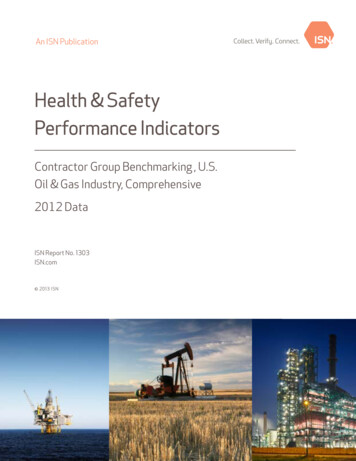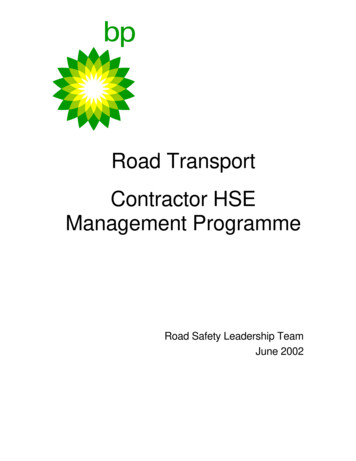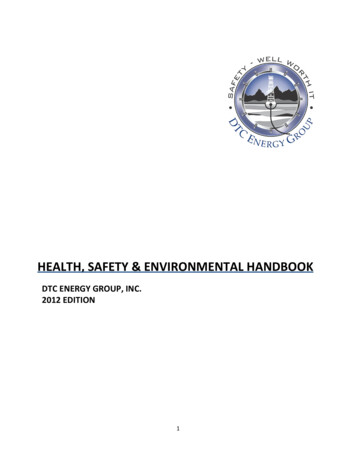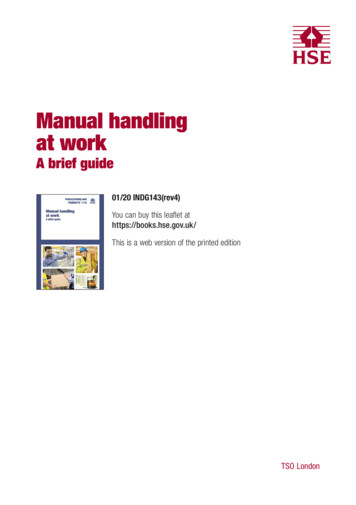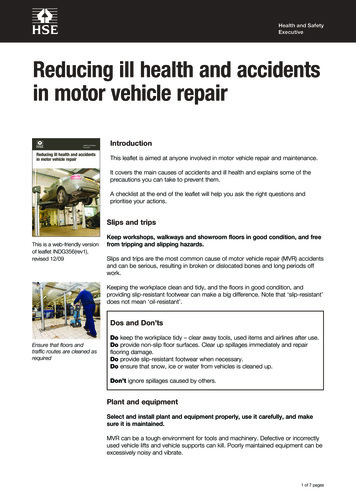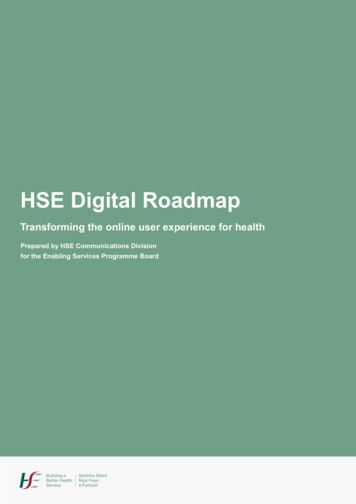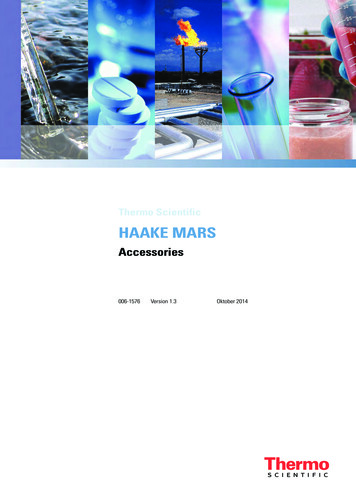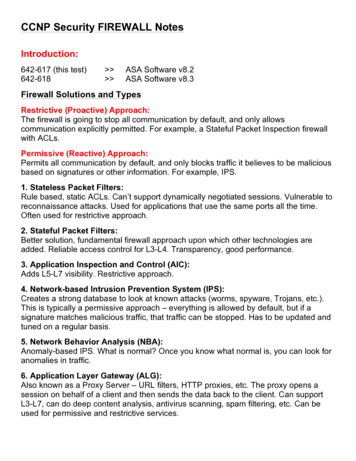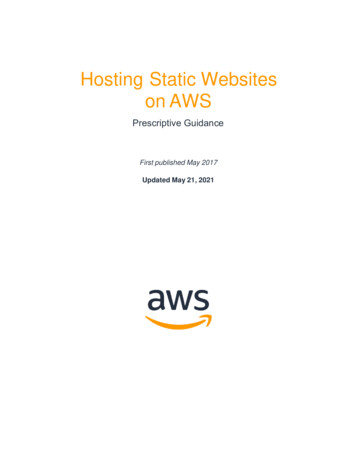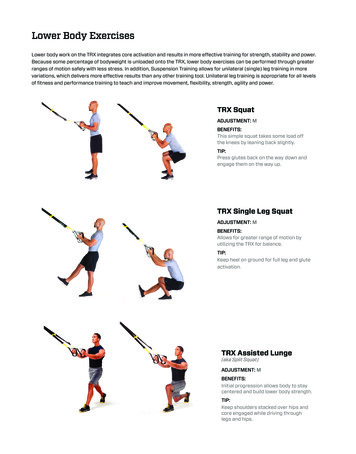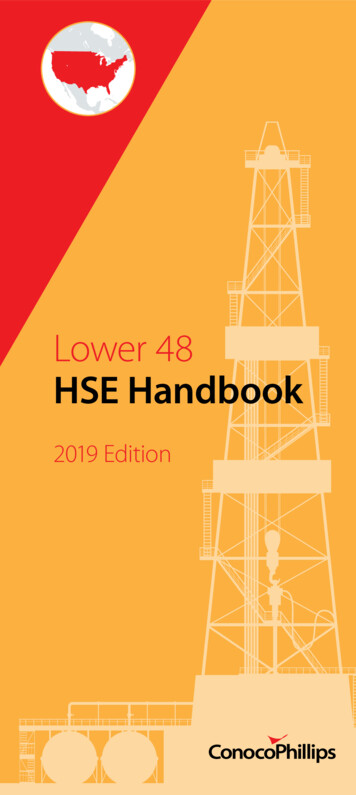
Transcription
Lower 48HSE Handbook2019 Edition
Message from Dominic MacklonColleagues,It is my pleasure to provide you with the 2019 edition of theLower 48 HSE Handbook. This year we’ve tried to focus onaddressing the daily needs of those working in the field.There is important information provided for all Lower 48employees and contractors, but we wanted to ensure it couldbe used as a quick reference for HSE topics faced by ourfield personnel on a daily basis. We are also providing thehandbook in multiple formats, including a mobile app, foreasy access. Our Life Saving Rules are prominently featured,and we are introducing new Process Safety Fundamentalsguidance.As you are all aware, our SPIRIT Values place Safety first andforemost. That is critical to ensure everyone returns homesafely every day. To accomplish that, we should be “AlwaysProfessional, Always in Control.” Focusing on that mindsetand utilizing the information provided in this handbook,will help position us for our 2020 goal of zero significantincidents and a continuous improvement in TRR.As you prepare to start work each day, I ask that you and yourco-workers consider these questions:1. Have we planned the job properly, designed theequipment properly, and identified the remainingjob-specific hazards and risk mitigations?2. Are the people conducting the work adequatelytrained and competent to perform the work safely?3. Do our work practices and procedures lead to safeexecution and are they being followed?4. Have we VERIFIED that we are honoring the identifiedhazard mitigations and controls?5. Are we taking the time necessary to be safe, and arewe ready to STOP the job if there’s ANY doubt?I genuinely want each and every one of you to return homesafely at the end of each day. As we continue our safetyjourney, I hope the information in this handbook will assistyou in executing your work safely.Dominic MacklonPresident, Lower 48At ConocoPhillips, our work is neverso urgent or important that we cannottake the time to do it safely.2
ExpectationsLower 48 Safety ExpectationsThe following expectations apply to all personnel working ona ConocoPhillips Lower 48 location: Report all unplanned events and any injury, no matter howminor, to a ConocoPhillips supervisor as soon as possible. For injuries, call your asset’s medical case managementservice (typically, this is Axiom 1-877-502-9466). Attend an asset-specific safety briefing or orientationbefore going to work. Before working on one of our sites, attend aConocoPhillips Safety Leadership Seminar (SLS) or HazardRecognition & Management Workshop (HRMW) followedby SLS within 6 months. Complete all required HSE training for your position. If available, follow the safe work procedures andguidelines for the job you are doing.If safe work procedures or guidelines arenot available, and you feel the job is unsafe! to start, exercise your Stop Work Authority! Use the Job Safety Analysis (JSA) process and GO card toidentify hazards and take appropriate action:– A JSA should focus on a few job steps at a time, thenrefresh the JSA as job steps are completed.– When hazards are identified, steps must be taken toeliminate or mitigate those hazards.Note: “Be aware” or “Be careful” are not acceptablemitigations. Eliminate hazards or reduce their risk to anacceptable level with protective barriers (physicalbarriers, specialized equipment, procedures, etc.) Actively participate in a Behavioral Based Safety (BBS)program by observing, intervening and reporting.STOP all unsafe acts that you see and have!a meaningful discussion with the individualor crew such that they also understandthe unsafe act and both of you agree on asafer alternative to complete the work! Submit Hazard ID or similar reports for any potentiallyunsafe conditions you observe. These may includeequipment, procedures or even lack of training orunderstanding.3Table of Contents
HSE Management System(HSE MS01)The L48 HSE Management System is a detailed plan of: How to manage HSE risk and protect the health and safetyof COP workers, contractors and nearby communitiesalong with the environment. What the L48 organization will do to comply with thecorporate HSE MS Standard. The processes, programs and procedures (methods) usedto plan, do, assess and adjust our system to continuallyimprove HSE performance in each of the 15 Elements ofthe Management System.Note: More details on many of the subjects presented inthis manual can be found by accessing the HSEManagement System.4
Table of ContentsTable of ContentsMessage from the Lower 48 President.2Lower 48 Safety Expectations.3The HSE Management System.4Life Saving Rules (LSR)—Summary.9LSR - Line of Fire.11LSR - Work Permit*.13LSR - Confined Space Entry*.19LSR - Working at Heights*. 25LSR - Lifting Operations* .35LSR - Energy Isolation*.45LSR - Ground Disturbance/Excavation* (incl. Hand Digging).55LSR - Bypassing Safety Devices*.61LSR - Driving Safety*.67Process Safety Fundamentals*.73Abrasive Blasting.81Air Compressors and Air Receivers.81Asbestos (Respirable Fibers)*.81Asset & Operating Integrity (A&OI)*.82ATVs, UTVs and Snow Vehicles.83Axiom. 84Barricades. 84Benzene*.85Bloodborne Pathogens*. 86Boomers, Binders and Come-Alongs. 86Burn Ban Conditions. 86Camlock Connections.87Carbon Dioxide (CO2) and Nitrogen (N2).87Compressed Gas Cylinders. 88Contractor HSE Management*. 88Control of Work (incl. PIC and Critical Activities). 89Drilling & Well Servicing (incl. Swabbing and Wireline Ops.). 90Drug, Alcohol and other Contraband Policy.92Electrical Safety*.92Emergency Response*.93Environmental Topics*. 94Ergonomics*.97Extracting Stuck Vehicles.97Fatigue Management*. 98Fire Protection*. 99First Aid Kits. 101Flagging & Tagging*. 101Grinders and Wire Brush Wheels. 103Grounding/Bonding. 104Handle Extensions (Cheaters). 105Hand Tools. 106Hazard Communication* (also see Appendix F). 108* Topics with an asterisk* have an associated manual orprocedure in the HSE Management System where additionaldetails and instructions can be found.5Table of Contents
Table of Contents, cont.Hearing Conservation*. 108Helicopters*. 109Hot Oiling/Watering.110Hot Work* (incl. Hot Tapping, Hot Tie-In & In-Service Welding).111Hydrates.115Hydrogen Sulfide (H2S)*.116Hydrotesting.119Incident Reporting and Investigation*. 120Knives and Razors.121Ladder Safety*.121Lighting Burners on Fired Vessels. 122Lone Worker. 123Long-Term Isolations. 123Machine and Equipment Guarding. 123Management of Change (MOC)*.124Manual Lifting and Carrying Loads.124NORM—Naturally Occurring Radioactive Material*. 125Painting. 126Personal Protective Equipment* (refer to asset PPE Matrix). 126Pigging Operations.131Pipe Handling and Storage.131Pressure—Working with (Trapped, Systems, Venting/Bleeding).132Pressure Washer Requirements. 134Pre-Startup Safety Review (PSSR)*. 135Pumping Units. 135Pumps. 136Purging Operations*. 136Quality Management System (QMS)*. 136Radiation Safety.137Relief Devices*.137Respiratory Protection*. 138Rotating/Reciprocating Equipment. 139Scaffolding*. 139Short Service Employee. 140Signs.141Simultaneous Operations.141Slips, Trips & Falls (incl. Walking & Working Surfaces). 142Static Electricity. 143T-Post Drivers. 144Temporary Equipment. 144Unsecured Objects (Drops, Shifts & Rolls). 145Vac Truck Operation. 145Weather (Precautions, Related Illnesses). 146Welding and Cutting. 149Wildlife and Plants. 152* Topics with an asterisk* have an associated manual orprocedure in the HSE Management System where additionaldetails and instructions can be found.6
Table of ContentsAppendices:A: Charts, Tables and Formulas. 154Anchor Selection Worksheet. 154Carbon Steel Flanges—Pressure/Temperature Ratings. 155Conversion Factors. 157B: Crane Signals. 165C: Flanges and Flange Bolt Dimensions. 168D: Fantail Blind Plates.171E: Geometric Formulas. 173F: HazCom—GHS Pictograms and Hazards.174G: Loads on Blocks.175H: Pipe Schedules.176I: Rigging Practices, Good and Bad. 177J: Wire Rope and Clips. 179K: Acronym List. 180Scan for L48 HSE Management System site.7Table of Contents
Life SavingRulesTable of Contents
Life Saving RulesFurther detailed on following pagesLine of FireKeep yourself and others out ofthe line of fire.Work PermitObtain a valid work permit when required.Confined Space EntryObtain authorization before entering aconfined space.Working at HeightsProtect yourself against falls when workingat heights.Lifting OperationsFollow safe lifting operations and do notwalk under a suspended load.Energy IsolationVerify isolation before work begins.Ground Disturbance/ExcavationObtain authorization before starting grounddisturbance/ excavation activities.Bypassing Safety DevicesObtain authorization before bypassing,inhibiting, or defeating a safety protectiondevice or equipment.Driving SafetyWhile driving wear your seat belt, do notuse your mobile phone and do not exceedspeed limits.10
Line of FireTable of Contents
Line of FireLine of FireKeep yourself and othersout of the line of fire.Establish and honor barriers and exclusion zones.Position yourself and others to avoid: Pressure releases Vehicles and heavy equipmentDropped objects and suspended/swinging loadsMoving objectsEquipment under tensionPinch pointsSecure loose and potential dropped objects.12
Work PermitTable of Contents
Work Permit. 15 When is a Work Permit required?. 16 When is a Work Permit not required?. 16 Who needs to approve a Work Permit?. 16 What questions should be askedduring the Work Permit approval process?. 16 Where should a copy of the Work Permit be kept?.17 When should a Work Permit be suspended?.17 When should a Work Permit be canceled?.1714
Work PermitWork PermitWork with a valid work permitwhen required.Working with a valid work permit is required, but apermit alone does not make the job safe. Before a workpermit can be issued, the following minimum followingminimum requirements must be met: All those who are involved in the work permitting processhave been trained and proven competent in their roles andresponsibilities. The scope of work has been well defined for the specificwork location. Any change in the scope of work is accounted for bystopping the work, reassessing the risk, and reviewing/revising the permit, as appropriate. The permit issuer and responsible persons have identifiedany interactions with other work permits, work tasks, and/or simultaneous operations and these are cross-referencedon the permit. All hazards, including Line of Fire, have been identifiedand assessed; risks have been mitigated; and the necessarycontrols have been put in place. Changing hazards have been considered, and workers havebeen trained to recognize changes. Responsible persons have validated hazards mitigationand permit requirements at the work site prior to the startof work. All required signatures for the permit have been obtainedfrom the designated responsible persons. Responsible persons have verified the integrity of anyisolation required for the work to proceed. The scope of work, permit conditions and risk assessmenthave been communicated to all persons involved prior tothe start of work as well as to those persons who come tothe work site after work has started. Required atmospheric testing has been completed;results have been evaluated and documented; and repeator continuous testing requirements are part of the permitconditions. For ongoing work, handover discussions are conductedbetween responsible persons of each shift, and the workpermit is revalidated, as appropriate.15Table of Contents
Work PermitWhen is a Work Permit required? A general permit to work is required for the followingnon-routine work activities at Class A, B and PSM facilities:– General/Cold Work.– Class A & B Hot Work.– Confined Space Entry.– Excavation Work.– Lifting Operations.– Work requiring Energy Isolation. Activity-specific permits are required at ALL L48facilities for the following routine and non-routineactivities:– Confined Space Entry.– Excavation.– Lifting/Rigging.– Hot Work Class A & B (some Class B Hot Work is excludedfrom permit requirements; see Hot Work requirementsfor additional information).When is a Work Permit not required? When “routine” work is being performed such as:– Identified as low risk per L48 Risk Matrix.– Systems with a voltage 50 Volts.– Work not requiring an L48 work permit (LOTO, HotWork, Confined Space Entry, etc.).Who needs to approve a Work Permit? A COP Foreman, Supervisor or Superintendent (ordesignee).What questions should be asked during the WorkPermit approval process? Is the work required? Are the Work Permit and documentation complete? Does the work involve a Management of Change? Has itbeen approved to implement? Will this work involve SIMOPS (Simultaneous Operations)on the site? Is the Operations Manager’s written approval required forany work in a hazardous area? Are all the requirements understood by all parties? Are all HSE and Process Safety risks understood, andappropriate mitigations planned or in place? What is the impact on other activities in the area?16
Work PermitWhere should a copy of the Work Permit be kept? At the work site.When should a Work Permit be suspended? When work is interrupted. Examples of work interruptioninclude:– Fire or gas alarms.– Hazard introduction from SIMOPS.– Conflicts with scope of work.Work cannot resume until the Work Permitis reauthorized by the Authorizing!Representative!!When should a Work Permit be canceled? When the job scope changes. Examples of job scopechanges include:– LOTO is not completed.– Work cannot be performed as planned.– SIMOPS conflict that cannot be resolved.Work cannot resume until a new WorkPermit is generated and approved for issue!!17Table of Contents
ConfinedSpace EntryTable of Contents
Confined Space Entry.21 What is a Confined Space?. 22 What is entry?. 22 What are the different types of Confined Spaces?. 22 What defines a Permit-Required Confined Space?. 22 What defines a Re-Classified Confined Space?. 23 How are Confined Spaces marked?. 23 CSE Key Steps . 23 Additional information for atmospheric testing .2420
Confined Space EntryConfined Space EntryObtain authorization beforeentering a confined space.All confined space entry requires authorization. Seelocal rules and regulations for specific requirements.Additionally, before authorization to enter a permitrequired confined space is given, the followingminimum requirements must be met: The permit has been issued and authorized with allresponsible persons’ signatures and has been posted atthe confined space entrance. Hazard analysis has been conducted to verify that allhazards associated with the entry have been recognizedand mitigated. Only confined space trained personnel are allowed toenter and work in the confined space. Changing hazards have been considered, and workershave been trained to recognize changes. Permit conditions and risk assessment have beencommunicated to all affected personnel. Pre-entry preparation and inspection have beencompleted to verify that all appropriate controls andisolations are in place and verified. Required atmospheric testing has been completed;results have been evaluated and documented; and testingis repeated as described by the permit conditions. Emergency rescue procedures and resources have beenput in place and tested. An attendant is present whose sole responsibility is tomaintain communication with entrants and to raisean alarm in the event of an emergency. The attendantunderstands the assigned duties and knows not to enterthe confined space for any reason. Controls to prevent unauthorized access are alwaysin place.21Table of Contents
Confined Space EntryWhat is a Confined Space? A space that meets the following three requirements:– Is large enough and configured such that a person’sentire body can enter.– Has limited or restricted means of entry or exit.– Is not designed for continuous human occupancy.What is entry? Entry occurs as soon as any part of the body breaks theplane of an opening into the space.What are the different types of Confined Spaces? Permit-Required Confined Space. Re-Classified Confined Space.What defines a Permit-Required Confined Space? Contains or has the potential to contain a hazardousatmosphere that exposes employees to a risk of death,incapacitation, injury or acute illness from one or more ofthe following causes:– Oxygen concentration below 19.5 percent or above23.5 percent.– Flammable gas, vapor or mist more than 10% of itslower explosive limit (LEL).–Airborne combustible dust at a concentration thatmeets or exceeds its lower flammability limit (LFL). Thiscondition may be approximated when dust obscuresvision to 5 feet or less.– A concentration of any substance that could result inemployee exposure in excess of the permissibleexposure limit (PEL), e.g., H2S-Hydrogen Sulfide.– Any condition recognized as immediately dangerous tolife or health.– Contains a material that has the potential for engulfingan entrant.– Has an internal shape such that an entrant could betrapped or asphyxiated by inwardly converging walls orby a floor that slopes down and tapers in.– Contains any other recognized serious safety or healthhazard. Permit-Required Confined Space requires an approvedpermit, signed by a supervisor, before work may proceed.22
Confined Space EntryWhat defines a Re-Classified Confined Space? The identified atmospheric, physical, and occupationalhealth conditions are within nonhazardous limits.Note: This reclassification process must be documentedon the CSE permit form.How are Confined Spaces marked? Signs or other effective means of warning must be postedon confined spaces that can be entered easily (without theuse of tools or keys).CSE Key Steps1. Isolate energy sources using LOTO. If positive isolationcannot be accomplished, the double block and bleedmethod can be used, but the bleed/vent must be lockedopen and monitored during CSE.A single closed block valve is never allowed! as an isolation method for CSE!2. Clean, purge and ventilate the confined space.3. Test the entire confined space using a direct-readinginstrument and record results on the CSE permit form.4. Complete a hot work permit if required.5. Install barriers if needed.6. Complete the CSE permit form and post near theentrance to the CSE.Note: The CSE Supervisor is not required to remain onsitefor a reclassified CSE, so these duties will belong to theLead Worker. If reclassification is not possible, the CSESupervisor will remain onsite.7. Ensure the rescue team, equipment and attendant areready (not required for Reclassified CSE).8. Ensure continuous monitoring while entrants are in theconfined space.9. Document the atmospheric readings every 2 hours on theCSE permit form (not required for Reclassified CSE).23Table of Contents
Confined Space Entry10. Complete a new CSE Permit form if: Permit duration exceeds 12 hours. Entry spans a crew change. A Stop Work Order is given.11. STOP the work and remove entrants from the confinedspace if any unanticipated hazardous condition isdetected during the entry.12. Complete CSE by: Removing all personnel and tools. Installing a barrier at the entrance. Conducting a debrief (not required for Reclassified CSE). Closing the CSE permit.Additional information on atmospheric testing Use a probe or extension on the testing equipment forconfined spaces that are deep, have odd shapes or includeremote areas. Individuals cannot physically enter a confined space toobtain a test reading without meeting the conditions ofeither a permit required or reclassified confined spaceentry.When conducting atmospheric testing,make sure to test at multiple elevations/! areas of the space to account for vapors/gases that are lighter or heavier than air!24
Working atHeightsTable of Contents
Working at Heights (Fall Protection).27 When are you required to use fall protection?. 28 How do you know when to use fall protectionand what type?. 28 What are the different types of fall protection?. 28 Hazard Elimination. 28 Passive Fall Protection. 29 Fall Restraint System. 29 Fall Arrest System. 30– Retractable Fall Arrest System. 30– Self-Retracting Lanyard. 31– Fall Arrest Shock-absorbing Lanyard. 31 Do fall arrest systems have to be attached toan anchor point?. 31 What are some other requirements forfall arrest systems? . 33 What are the rescue requirements whenusing a fall arrest system?. 34 What do you look for when inspecting fallprotection equipment?. 3426
Working at HeightsWorking at Heights(Fall Protection)Protect yourself against afall when working at heightUse fall protection when working outside a protectivework environment. See local rules and regulationsfor specific height requirements. A protective workenvironment includes approved scaffolds, stairs andplatforms with handrails, mid-rails and toe boards, andapproved mobile work platforms. Before working atheight proceeds, the following minimum requirementsmust be met: Options to eliminate the need to work at height have beenassessed. Where practical, a fixed or mobile work platform withhandrails, mid-rails, and toe boards is used. A competentperson must approve these platforms. The fall arre
Lower 48 HSE Handbook. This year we’ve tried to focus on addressing the daily needs of those working in the field. There is important information provided for all Lower 48 employees and contractors, but we wanted to ensure it could be used as a quick reference for HSE topics faced by our fi
